When James posted his work on this pipe on the pipe forums I was amazed at how beautiful it looked. Wow a 1901 BBB – one of my favourite pipe makes and one of the old ones as well. Imagine the surprise when I got an email at the same time asking if I would like a write up and photos of the restemming for the blog. I did not have to think twice to answer that email. I quickly fired back an affirmative and what you have below is the story from James. Thanks again James for taking the time to document your work on this old timer. Enjoy smoking that great piece of pipe history. Below is his tale.
Every story has a beginning and this one even has a pre-story. The excerpt below was posted on several forums I’m a member of so I thought I would repeat it just for those that haven’t seen the posts.
“As some of you know I attend the 100km van Ieper in Belgium nearly every year since 2002. It’s a walk around the WWI Battlefields that consumed Ieper. I’ve been bitten by the pipe making bug, and how and along the way dabbled in restorations just because, but my search for a pre-WWI era pipe is finally over. I ended up getting this piece of history from Alan at Reborn Briar. Now he did the pipe restoration.. and a brilliant job he did, the only thing the pipe was missing was a stem.. well I can do that… I decided not to bore out the mortise and left it threaded, made a threaded tenon out of horn, since I don’t have any workable bone, and decided against using Ivory…… and went with Cumberland for my stem material.. I’m happy…Happy Columbus Day everybody”
Now for the rest of the story. What sticks around in usable condition for over 100 years… not too much, but since I’m kinda into this pipe thing, tobacco related history rates up there for my interest factor. This past July I was able to attend the Newark (UK) Pipe show, set up a table and sell some pipes. You never really sale (or at least I don’t) all the pipes you want to sale, but you do get to meet a lot of really interesting people, and the next table over was Alan Chestnutt from Reborn Briar. I’m always amazed at the folks like Steve and Alan that get into the restoration business. I’ve done a few, even wrote an article about it, but creation is where my passion lies.
Anyway, talking with Alan pre-World War I pipes came up, and fast forward to September he had one that he was going to restore but without a stem. As I mentioned above, stems are no problem…. that’s the making/creating/using machinery aspect I like. When the pipe arrived I was amazed at how well it looked. I mean wow, 1901, and all that.
The only real thing that threw me was the threaded mortise. Looking around the shop I pickup up a few of my mistake mouthpieces and tried fitting a few. The 7mm tenon fit without a problem, as it just slid into the mortise. But later that night while sitting around thinking about the mouthpiece I figured I’d make it as close to the original as I could. The stems profile was already in the leather case. So what do we know at this point.. 1900’s meant ivory, bone, or the like type of tenon. I don’t have any bone to use and didn’t really want to use ivory……but being a pipe maker I do have horn. I usually end up keeping the horn points after using the remainder of the material for a shank extension.
So horn it was to be. I shaped the tenon, drilled and set out to thread the tenon. I’m sitting with a 8mm tenon drilled to 4mm for the airway and went about threading the horn. Unfortunately it crushed under the pressure of my die, but I guess it only made sense… so I made another, except this time I threaded it first and then drilled it… And here is where the pictures come into play.
Threaded tenon, prior to drilling

And it fits just like it is supposed to. Looking right above the pipe you can see my trial delrin tenon with new threads.

Mouthpiece rough cut and drilled. The mortise is also threaded. I cleaned up the junction end before the next steps, so the fit would be flush
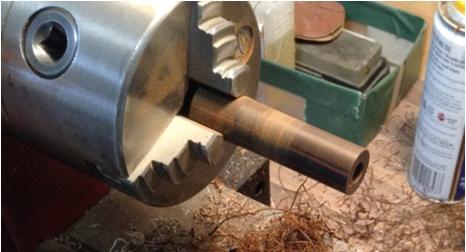
Epoxy’d and left to rest a while.
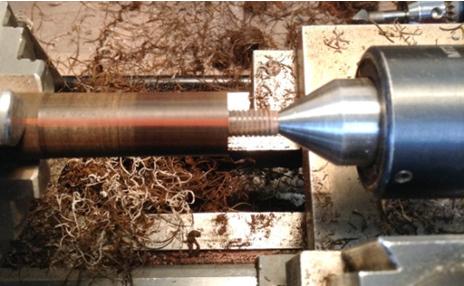
And it fits. So at least the scary parts are now done.
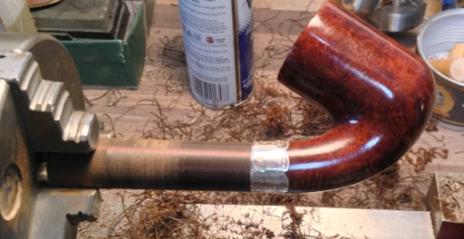
Drawing on the Cumberland to get my bearings at to decide where I want the saddle to sit. The line closest to the junction was chosen.

Time to sand a bit with a machine.

And more sandpaper… I probably left a step or two out here…just to save the pictures, but my process is machine, medium cut file, fine cut file, another fine cut file, nail files, 180, 220, 320, 400, 600, 800, 1200 sandpaper, buffing paste, more sanding, high glass paste (Sometimes more sanding to remove scratches I missed) and a final buff. Here you can see the stem is bent to its final form.

And here are the final pictures. Alan did the bowl, I did the stem and I have a pipe that is twice my age… gotta love it. Hope you enjoyed my story.



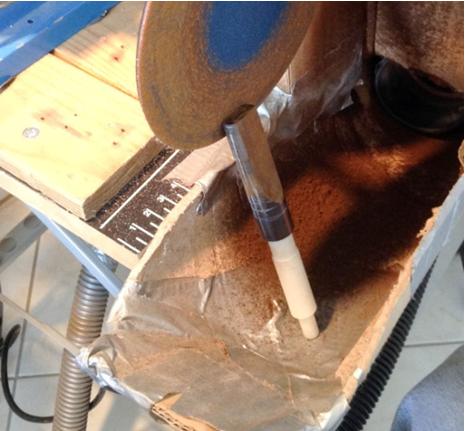

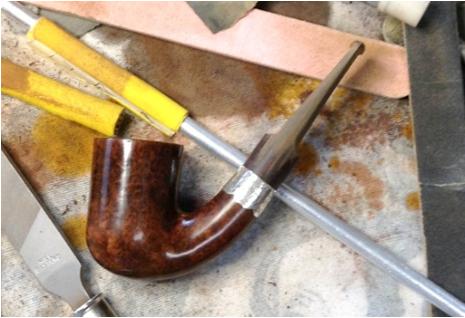
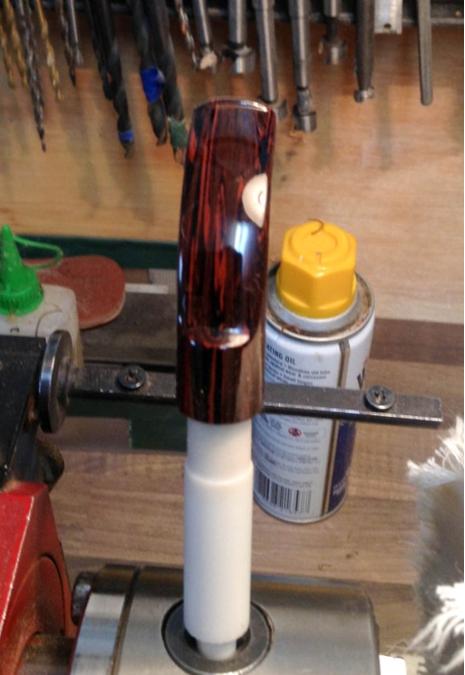



Pingback: The Decline of Restoring Old Pipes, Part 1/4 | rebornpipes
Beautiful job ob the restoration and tenon work, as well as the special details. Your tenon idea is of great help for a blog I’m writing about diminishing supplies for restoring old pipes and even new meerschaums.
LikeLike
I’m speechless… The cumberland stem is a spot on job. For me the grain in that bowl is mesmerizing. I can’t get enough of it. Like looking at the brush strokes of a Van Gogh. Put together it is a work of art. Well done gentleman.
LikeLike
Wow! Gorgeous restored, looks too pretty to smoke. Museum quality.
LikeLike
Beautiful collective endeavor, guys!! That is gorgeous with the cumberland.
LikeLike
James, and Alan, thanks for sharing the pictures and description on this project. What a magnificent piece of pipe history saved by your efforts. The BBB is stunning….a pipe anyone would love to own.
LikeLike
That is excellent work. Thanks for sharing the pix and write-up. I was particularly interested in how you made the screw in tenon. How challenging was it to get it to clock (line up) correctly? What a wonderful pipe, she looks ready for another 100 years.
LikeLike
As James said, it was a collaboration between us both. I think I got the easy bit in bringing the bowl back to life, but James has made this a stunning looking pipe with the addition of that stem. Another important piece of history saved.
LikeLike
Ah-ha, I see now, thanks!
LikeLike
It was my pleasure Steve…. Thanks for posting the story
LikeLike
Great pipe, great story and great team-work, well done the pair of you. 🙂
LikeLike
James that is one beautiful piece of work by both you and Alan. Lots of pipe envy here – my favourite pipe make and one with a jsecpipes handmade stem. Can’t get better than that. Thanks for writing this up.
LikeLike